Is battery the future?
Has technology evolved?
Charles Fowler
The development of battery-powered chainsaws has come a long way.
Stihl launched their first batteries in 2010 and since then have progressed to producing a new power laminate technology. This means the battery has double the number of maximum charging cycles, so you should be getting close to 10 years out of a single battery.
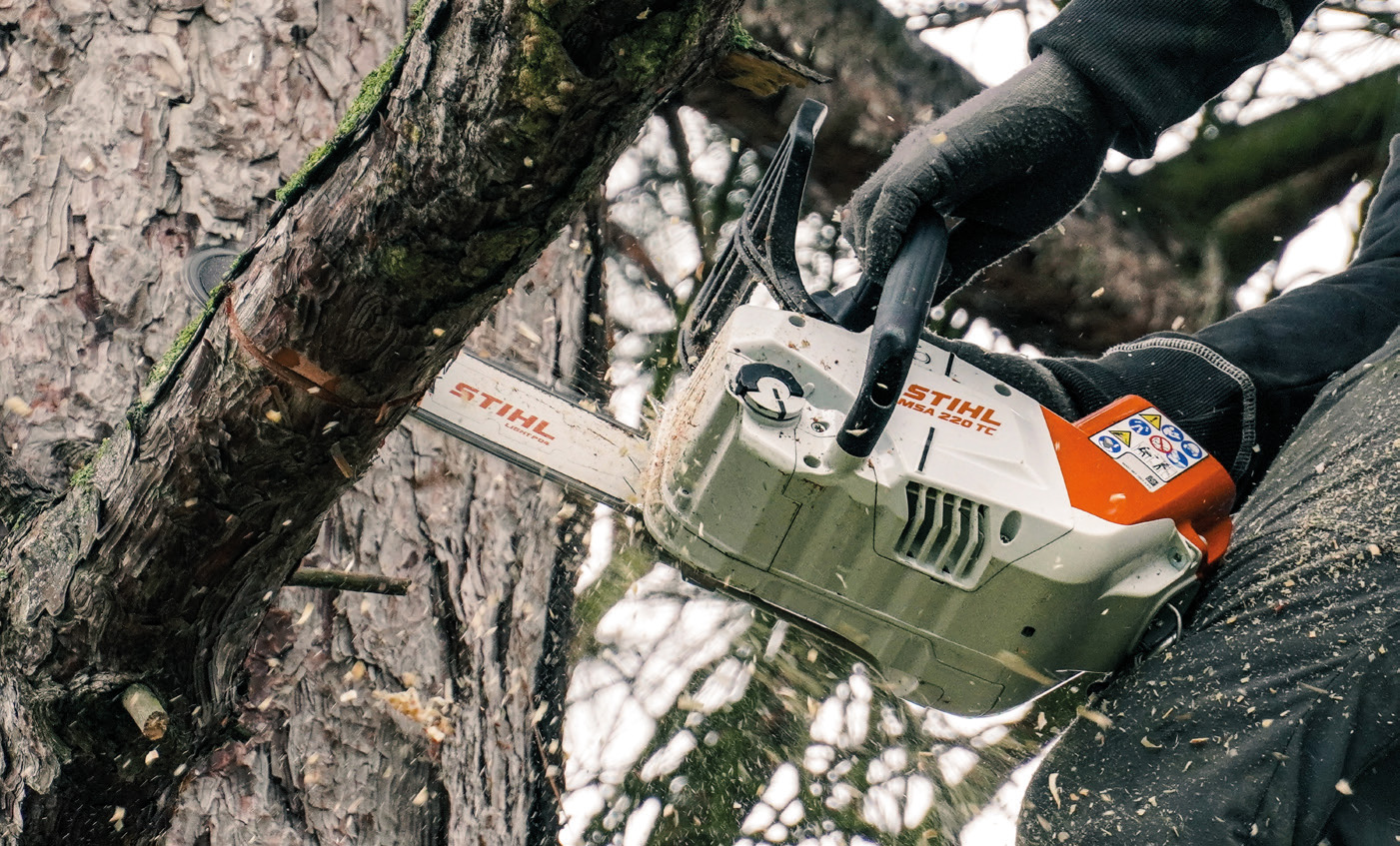
Stihl MSA 220 TC
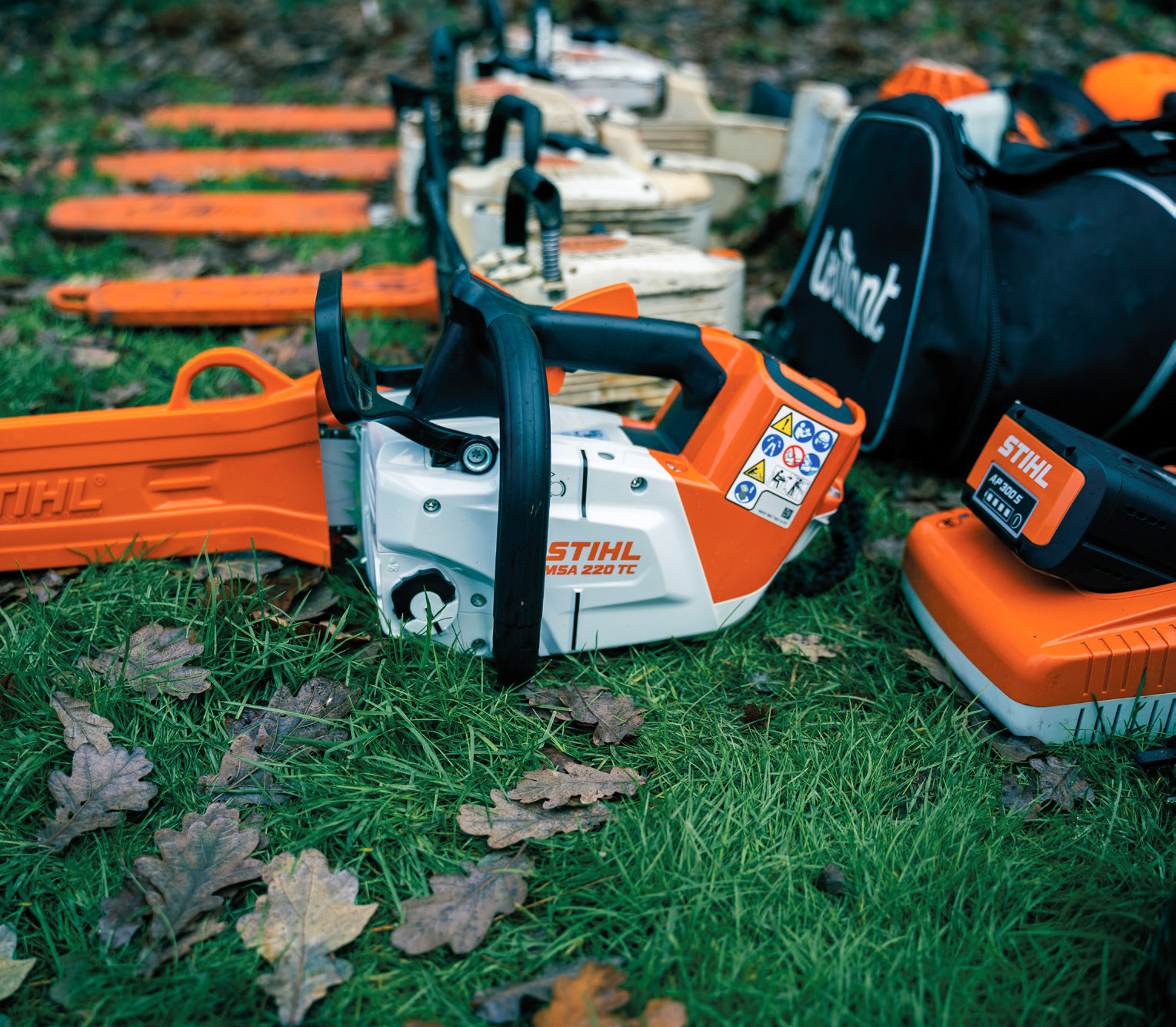
Stihl MS 220 T and charging system.
I have learnt that more volts don’t mean more power: the power is determined by voltage × amps. I have been using the AP range since 2019 and I don’t regret it one bit. I will be honest, when I asked about the MSA 160 T, I had such mixed reviews. The main problem was people judging this new technology and comparing it to a petrol top-handle like the MS 200 T. As a lot of people found out, there were a few small issues with this model to start with. Then the MSA 161 T was released so I bought this updated version instead. I could see more pros than cons. The obvious pros are less noise pollution, it’s lightweight and there are no harmful emissions. Plus the risks have been reduced significantly for carpal tunnel and white finger. We all know the massive issues we have with clutches and chain crawl, and with this battery-powered chainsaw these issues are just non-existent. I always maintained my saws, but we have all been there, pulling that pull-cord and nothing happens. I certainly don’t miss that. I just pick up and go.
Technically, with fewer mechanical parts, the chainsaw should need less maintenance. Generally speaking I do agree with this. However, I do find myself cleaning the bar, sprocket and side-casing daily. This is due to the battery chainsaw having little vibration and therefore the sawdust builds up quicker. But on the other hand, it is always good practice to check your safety features daily.
After being really impressed with the battery chainsaws, I invested in everything else – blowers, hedge trimmers, ground saws and more. I now do all my crown reduction work and pruning using completely battery power, not a drop of petrol in sight. I have used these machines in all English weather conditions from hot summer 40°C days to rain and snow in -10°C.
I have learnt that these batteries need a bit of looking after. Keep them dry and warm, and if a battery needs charging, it will only charge between +5°C and +40°C. If you have left your batteries in a container overnight and they are cold and flat, let them ride shotgun with you. That way they warm up in the cab and will be ready to charge at the client’s house (and that’s free!). If the battery is too hot to charge, yes the charger will cool it down first before it starts charging, but my battery blower cools it down quicker.
Stihl’s most powerful battery top-handle saw is here: the MSA 220 T. It has a chain speed of 24m/s, putting it on par with the MS 201 T petrol top-handle. This chainsaw is the first in its class, quick acceleration and more torque. Just make sure you have a few batteries to keep this saw going. The same goes for the MSA 300 ground saw, but with a chain speed up to 30m/s, that’s a fast chainsaw. This is fantastic for the groundsman. He could be snedding up that limb, still able to hear the climber if he needs to. Now that is a game changer.
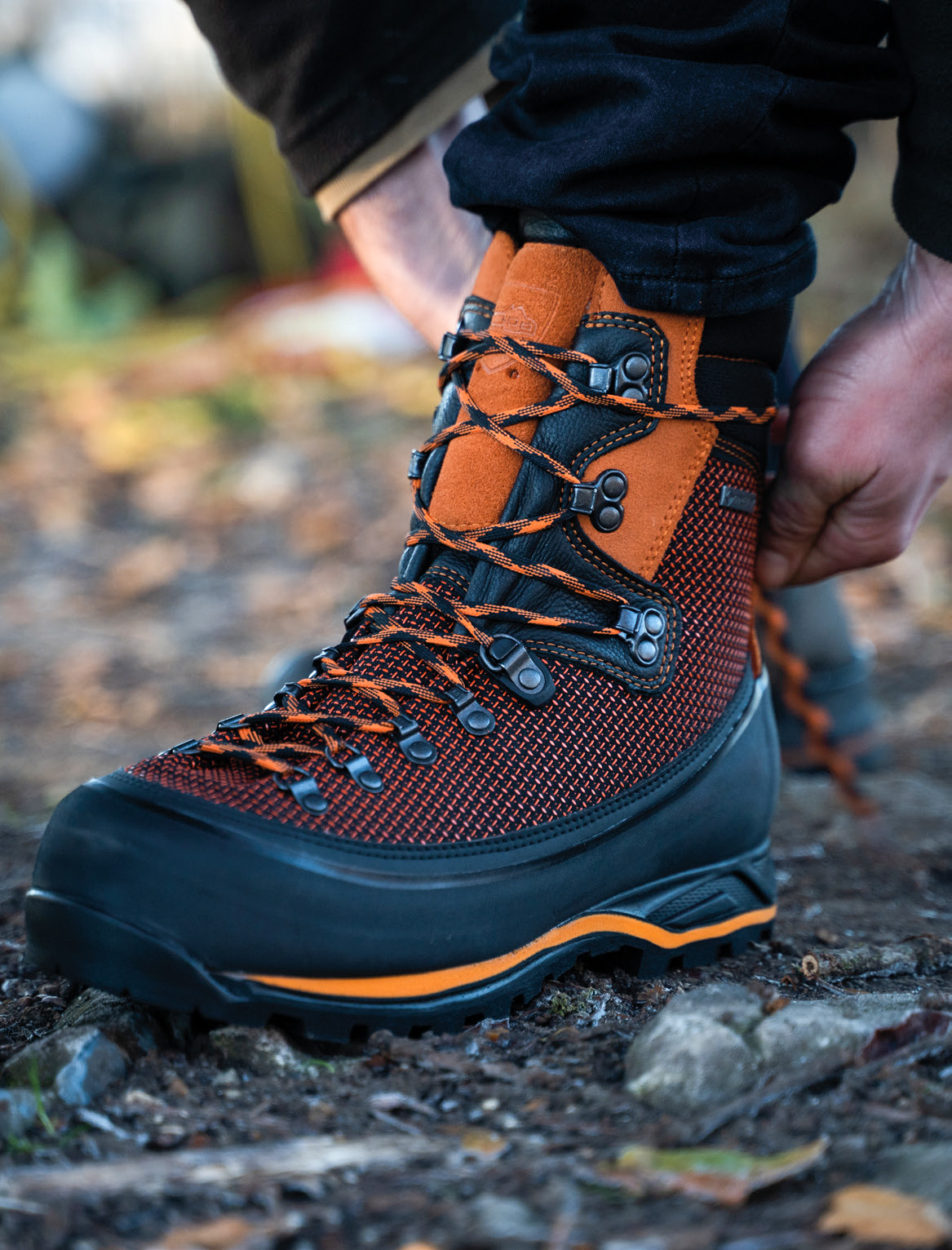
Jalas GTX boots
Jalas GTX boots
supplied by Sorbus international
Jonathon Dimmock
Jalas are a Finnish brand born in 1916. They strive for excellence and have a great reputation for safety workwear boots. This is their first move into chainsaw protective boots. And we were impressed!
First, opening the box you can’t miss that these are stand out, unique, modern-looking boots – a good fit for the newer era of tree surgeons and shiny things. They have a good-quality feel to them, with hard-wearing materials used throughout – similar in quality to the older Meindl and newer Andrew boots and with a similar price tag.
They have been comfortable from straight out of the box and didn’t need breaking in for me to happily be in them for a 10-hour shift, which is always a bonus. There’s nothing worse than worrying about changing boots halfway through the day.
So far, the GORE-TEX is doing its job in keeping the wet out without making it wet inside the boot. I’d like to give props to the useful design of the halfway lock on the laces, as once you’ve tightened the bottom half to your desired tension, it can be locked off to hold this position before you finish the top half of your boot – one of those things I didn’t know I wanted.
At the time of writing, we’re in the winter months here in the UK and this year it’s been particularly wet and cold. So far these boots are doing amazingly and I look forward to putting them through their paces over the coming year.
Feeling elevated
Leon Hottinger
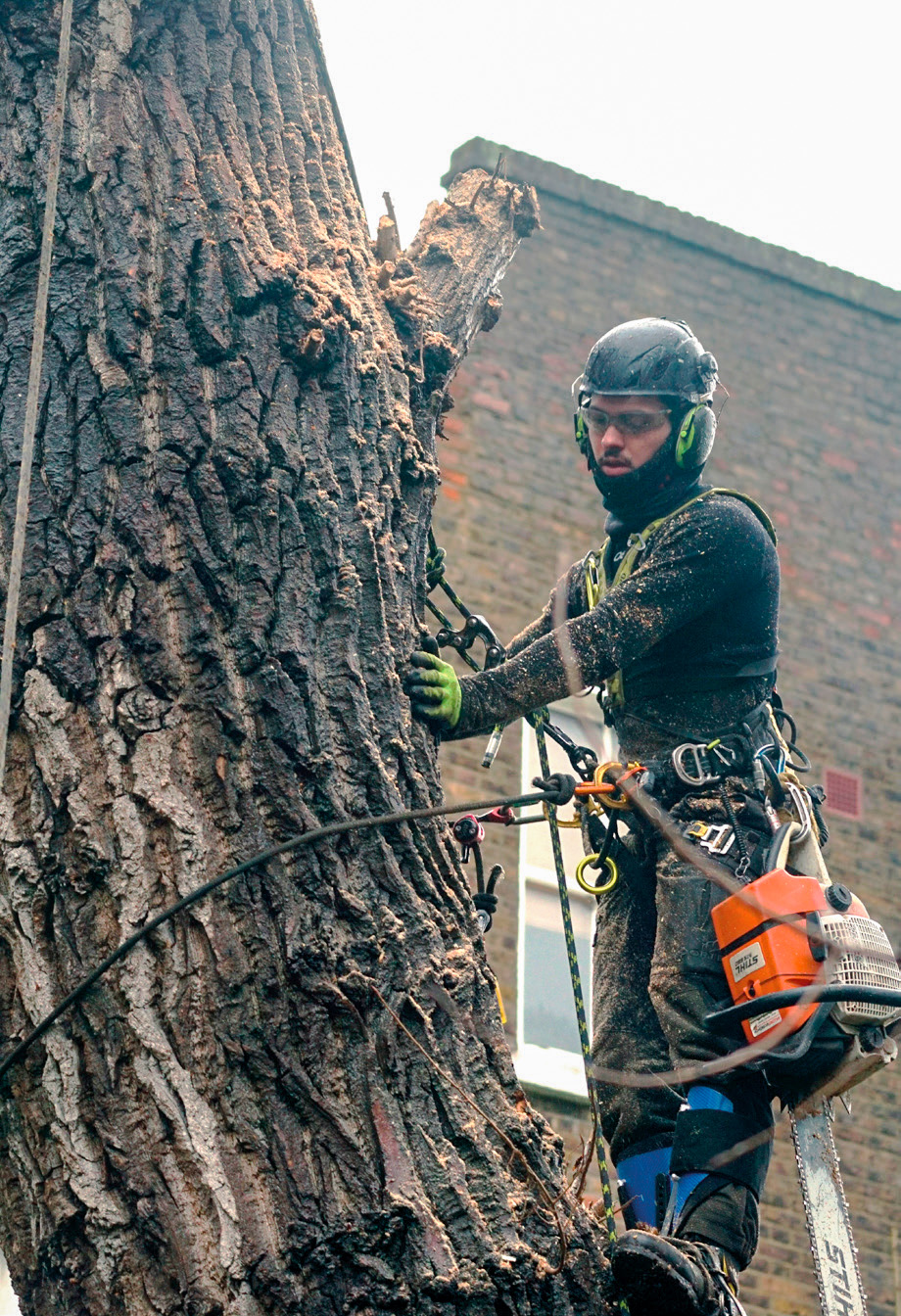
Blocking down a stem using Stein Elevate spikes.
The recently introduced Elevate spikes from Stein lend themselves nicely to the new and improved innovative kit within our industry.
There are some significant developments from their predecessors, the Aluminium Climbers, which were the original spikes from Stein that were favoured for years by many climbers and companies as they were robust, affordable and ergonomic. Stein have taken the pros from the Aluminium Climbers and built on them, creating a new and improved piece of kit that comes in the form of the Elevate spikes.
Whilst the spikes are still affordable, coming in at a cost of approx. £315 after VAT, Stein have added many more user-friendly features to the Elevates, incorporating ideas that give them an edge on the more expensive competition that is available on the market. The Elevates focus more on climbers’ variable preferences for how they like to wear their spikes. Personally, I think this is the biggest pro Stein have added to the Elevates, as choice of climbing kit – however good or bad – usually comes down to preference. The fact that the spikes are so adjustable, not only in height but also in angle, will be a big selling point to individual climbers or companies looking to invest in kit that will be universal to the workforce.
The Elevates include height adjustability with a full scale of 90mm from top to bottom on the calf pad, and if you’re shorter like me, this is a great adaption to cater for all sizes of climber. The instruction manual tells the user where the pad should sit for maximum comfort. A personal favourite feature for me, and something I haven’t seen before, is the ability to offset the shank from the pad by 4-degrees. I believe this is a standalone feature of the Elevate that really focuses on the thought that has gone into creating this kit, really thinking about climber ergonomics. The 4-degree offset gives the spike a slightly increased forward-facing angle, providing the climber with more purchase in the wood and reducing the probability of the spikes slipping out of the stem.
The pads are now made from thinner, 2 mm aluminium which means they can be easily manipulated to the calf of any climber. Ridges on the easy-adjust Velcro comfort pads give good ventilation when climbing and also allows the pads to once again be adjusted to climber preference. I like the fact Stein have used tried-and-tested methods like easy-to-put-on Velcro pads and the classic leather buckle system that provide a secure and comfortable fit.
A brilliant feature of the Elevates is the ease of on-site adjustment. The Allen keys placed flush in a little Velcro compartment on the right-hand pad mean easy changes can be made to the spikes without carrying any extra tools. I believe the Elevates will be popular amongst a majority of climbers, with the potential to become a favourite in the market due to the novel features which are combined with the favourable existing characteristics included in their design.
PulleyOne: is this the future of micro-pulleys?
Joseph Hottinger and Ethan Hottinger
The PulleyOne from At Height UK and Jammy Design redefines the concept of the micro-pulley.
Whilst many people may not have heard of At Height UK or Jammy Design, both brands’ pedigree hails from their founders, who have spent over 30 years in the working-at-height industry, innovating for names such as ISC Wales and 3M.

The PulleyOne.
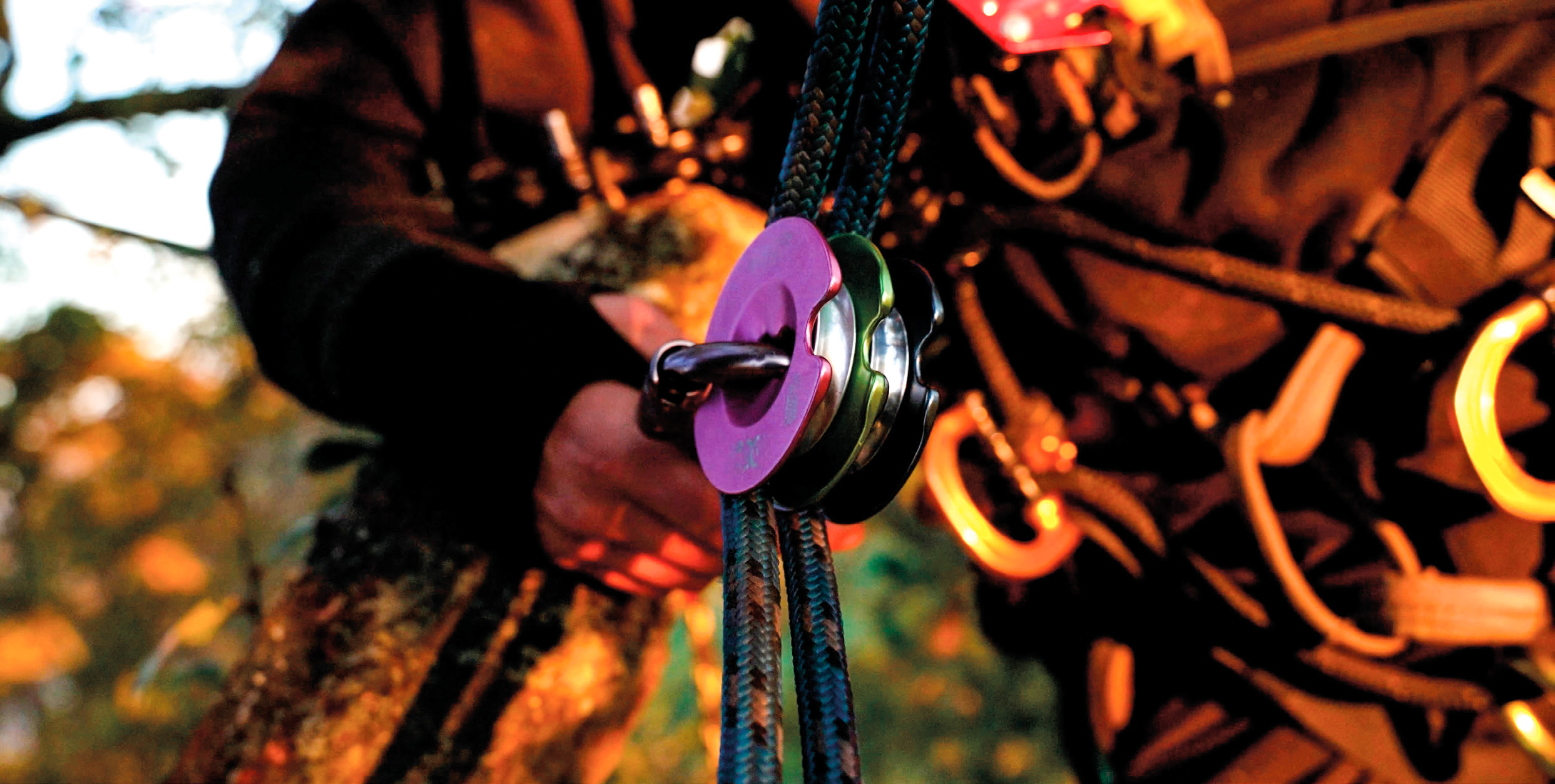
Horizontal stack DdRT.
What sets the PulleyOne apart from other conventional micro-pulleys is its large sheave diameter. From a physics standpoint, a larger pulley sheave translates to greater efficiency in operation (meaning more energy transferred in mechanical advantage systems, smoother redirects, easier hauling etc.). Normally this size of sheave would only be found on much larger, heavier rigging pulleys or blocks. To have such a large sheave in such a lightweight, low-profile package certainly gives it an edge when compared to the efficiency of other micro-pulleys in its class.
The carabiner attachment points have been carefully thought out, featuring cutouts on each side plate to ease carabiner installation, plus a connection aperture embedded within the sheave which allows two carabiners to be attached. This allows for some interesting configurations, like vertical stacking (useful for DdRT redirects), floating anchors etc. The central connection aperture is also rope and textile friendly, opening up more possibilities for creative configurations and fitting directly on to tool clips (such as DMM Vault) without the need for any extra gear.
The narrow profile of the PulleyOne also allows more than one to be stacked flush next to each other on large enough carabiners (useful for mechanical advantage systems and horizontal stack DdRT redirects).
The side protrusions ensure the rope stays snugly in place and have nice rounded edges. While the PulleyOne is optimised for 11.5 mm rope, we have found that thicker 11.7 mm ropes will still work well. More traditional 13 mm climbing lines would be too thick to sit in the PulleyOne’s protrusions properly.
One of the main benefits of the PulleyOne is that rope can be easily installed or removed whilst the pulley is set up. No more unclipping the pulley from the carabiner to insert the rope. Simply open the gate of the carabiner and pop the rope in! This is a welcome feature for climbers, who often find themselves balancing in awkward positions, juggling loose gear at the top of a tree, trying not to drop anything.
Whilst using the PulleyOne over the last few months we have found it to be a multi-functional harness companion. It is, however, limited by its rope diameter intake, making it incompatible with larger-diameter climbing ropes and the majority of rigging lines. Perhaps a rigging model of the PulleyOne would be a favourable addition to its line-up. Bear in mind, the PulleyOne does cost more than most other micro-pulleys available on the market, but you may find its greater functionality and efficiency make it the welcome inclusion you need for your climbing kit.
Be sure to check out the Canopy Climbing Collective YouTube channel, where you can find a video demonstrating the multiple uses of the PulleyOne.
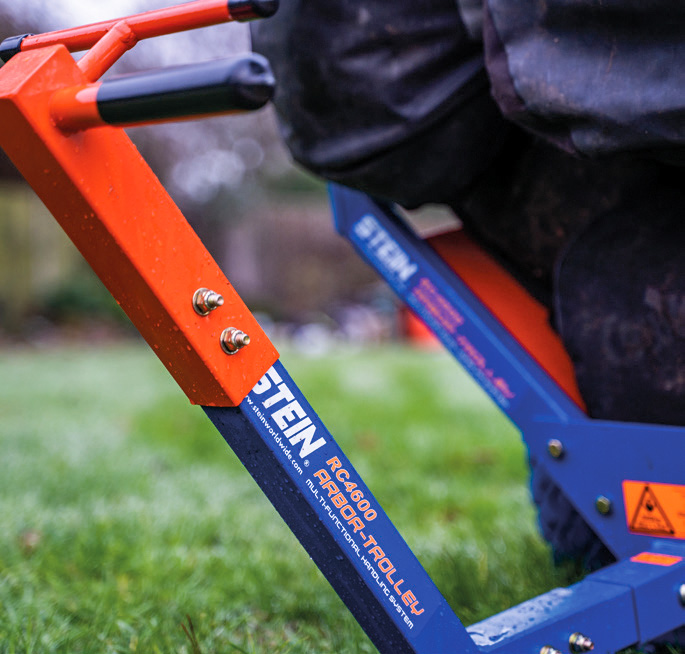

Stein RC4600 loaded for site setup.
Stein RC4600 – a NEW trolley is HERE!
Simeon Balsam
We all know that no matter how quickly the climber can dismantle a tree, it’s the ground crew that really determine the speed of the job. So who has the harder job, climber or groundsman?
In a world where efficiency is key, the original Stein arb trolley appeared on our shelves over 10 years ago. However, this new model comes with some upgrades. With a more compact design, gripper teeth for timber, bottom plates and a modular system that slides onto the placement poles to create a neat holding system, this new model is certainly more appealing and more versatile. Expect more bolt-on upgrades though!
We’ve all arrived on site and been greeted with a 100-foot drag, with feelings of doubt already kicking in. This blue steed is something you don’t want to forget. We’ve stacked the trolley over 5 feet high with brash, and using it you can pull over five times what one person can drag. The same goes for logs and even hauling kit into the work zone.
I asked the question, who has the hardest job, climber or groundsman? In the right scenario the arb trolley will even up those scales, making it easier for your ground crew to keep up with your climber. This is one piece of equipment you don’t want to go without.
This article was taken from Issue 200 Spring 2023 of the ARB Magazine, which is available to view free to members by simply logging in to the website and viewing your profile area.